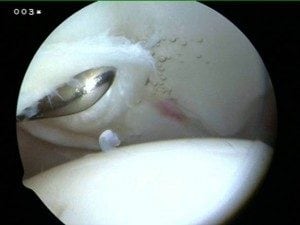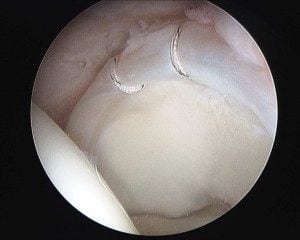What is the Labrum of the Hip?
The labrum of the hip is a thickened cartilage ring that lines the outer rim of the hip acetabulum (socket). The labrum functions to increase contact area in the hip and to maintain a fluid seal within the joint.

Arthroscopic probing of hip labral tear
The labrum also contains nerve fibers and tears can result in pain and mechanical symptoms. Tears of the labrum can occur for many reasons. Common causes can include trauma, repetitive activities, femoroacetabular impingement and early degenerative change.
Symptoms of Hip Labral Tears
Patients with tears of the hip labrum often will have deep pain within the groin or lateral aspect of the hip. The pain is usually quite deep and can not be “massaged” or “stretched.” Patients can not put their hand on the pain but there is obviously something wrong. Often a sensation of catching or popping is felt. Internal rotation of the hip can often recreate pain. Prolonged sitting, running and hip rotation (such as getting in and out of a car) can exacerbate symptoms. Often, sporting activities can exacerbate symptoms and patients are forced to give up many active pursuits.
Diagnosing Labral Tears of the Hip
Diagnosis of hip labral tears is usually done through physical examination and diagnostic imaging. The physical exam of the physician is critical. Patient history, provocative maneuvers and clinical judgment often lead to a strong suspicion of labral pathology. Diagnosis can be further substantiated by use of magnetic resonance imaging (MRI) with arthrogram. In this procedure a dye is injected into the hip joint to help identify labral pathology and then an MRI is performed.
Treatment Techniques for Tears of the Hip Labrum

Arthroscopic repair of labral tear in the hip
Labral tears of the hip can be successfully treated with hip arthroscopy. Dr. Wind has extensive experience in hip arthroscopy and commonly treats labral pathology. Usually, three small incisions are required to gain adequate access to the joint. Once in the joint, the labral tear can be identified.
Treatment depends on the type of tear. If the tear is primarily macerated or frayed, then the torn part of the labrum is excised with an arthroscopic shaver. This is called labral debridement. If the labrum is detached from the acetabular bone then labral repair back to bone is possible with the use of arthroscopic suture anchors.
Furthermore, if the cause of the labral tear is femoroacetabular impingement, it is important to not only treat the labral tear but the underlying impingement as well.
Frequently Asked Questions
This depends on whether the tear was treated with debridement or repair. If the torn part of the labrum was simply debrided then the patient is allowed to weight bear as tolerated. However is the labral tear was repaired back to bone using arthroscopic suture anchors then there is typically a period of 4-6 weeks where only minimal weight can be placed on the operative leg.
This depends mostly on the character of the tear. If the tear is macerated, meaning that the tissue is severely frayed, then debridement is a better option. If the labral tissue quality if preserved but the labrum is simply torn or detached from the bone then repair is usually performed. It is ideal to try to preserve the labral tissue if possible with repair, however many tears have tissue compromise and are not amenable to repair.
Almost all arthroscopic labral surgery is performed at an ambulatory surgery center meaning that patients go home the same day as surgery and are not admitted to the hospital.
Yes, we will schedule you to see one of our OrthoVirginia therapists within a week or surgery. If you choose to go to a physical therapist outside of OrthoVirginia then we will provide an order for you to take to the chosen location.
